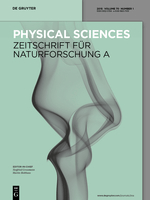
ZEITSCHRIFT FUR NATURFORSCHUNG SECTION A-A JOURNAL OF PHYSICAL SCIENCES
Scope & Guideline
Where Innovation Meets Tradition in Physical Sciences
Introduction
Aims and Scopes
- Theoretical Physics and Mathematical Modeling:
The journal emphasizes the development and application of mathematical models to describe complex physical phenomena, including nonlinear dynamics, stability analysis, and wave propagation in various media. - Material Science and Nanotechnology:
Research on the properties and applications of materials, particularly nanomaterials, is a core focus. This includes studies on structural, optical, and electrical properties, as well as the synthesis and characterization of novel materials. - Fluid Dynamics and Thermodynamics:
The journal publishes significant work related to fluid mechanics, including studies on non-Newtonian fluids, magnetohydrodynamics, and heat transfer phenomena, often incorporating complex boundary conditions and real-world applications. - Plasma Physics and Magnetics:
Contributions exploring the behavior of plasmas, including magnetized and quantum plasmas, are prevalent. This area covers topics such as wave interactions, stability conditions, and the effects of external fields. - Biophysics and Medical Physics:
The journal includes studies that bridge physical sciences with biological systems, particularly in understanding fluid dynamics in biological contexts, such as blood flow and the interaction of biological materials with physical forces. - Optoelectronics and Photonics:
Research on optical materials, sensors, and devices, including the development of photonic crystals and studies on light-matter interactions, is a significant area of interest.
Trending and Emerging
- Interdisciplinary Applications of AI and Machine Learning:
The integration of artificial intelligence and machine learning techniques into physical sciences research is gaining momentum. This trend highlights the growing importance of data-driven approaches and computational methods in solving complex scientific problems. - Advanced Nanomaterials and Their Applications:
Research on advanced nanomaterials, particularly in the context of energy storage, catalysis, and optoelectronic applications, is becoming increasingly prominent. This reflects a broader trend towards sustainable and high-performance materials. - Complex Systems and Nonlinear Dynamics:
There is a rising interest in the study of complex systems and nonlinear dynamics, particularly in biological and ecological contexts. This trend indicates a shift towards understanding intricate interactions within systems that may have significant real-world implications. - Quantum Technologies and Quantum Information Science:
Research focusing on quantum technologies, including quantum computing and quantum information science, is expanding. This reflects the growing importance of quantum mechanics in developing next-generation technologies. - Sustainable and Green Technologies:
The journal increasingly emphasizes research on sustainable technologies, including eco-friendly materials and processes, reflecting global trends towards sustainability and environmental consciousness.
Declining or Waning
- Classical Mechanics and Traditional Dynamics:
Research in classical mechanics, particularly topics that do not integrate modern computational or theoretical advancements, has decreased. This may indicate a shift towards more complex and interdisciplinary approaches that incorporate advanced methodologies. - Basic Quantum Mechanics:
There has been a noted decline in publications focusing solely on foundational quantum mechanics without applications or extensions to other fields, suggesting a trend towards more applied quantum research. - Conventional Energy Materials:
Studies centered on traditional energy materials, such as those that do not integrate nanotechnology or novel material science advancements, are less frequently published, indicating a pivot towards more innovative and sustainable energy solutions.
Similar Journals

International Journal of Mathematics and Physics
Illuminating the Path of Discovery in Mathematics and PhysicsThe International Journal of Mathematics and Physics, published by AL-FARABI KAZAKH NATIONAL UNIVERSITY, serves as a vital platform for scholars and researchers engaged in the fields of mathematics and physics. With an ISSN of 2218-7987 and E-ISSN 2409-5508, this journal has been committed to disseminating high-quality research since its inception in 2019, and will continue to do so until 2024. Although currently not an open access journal, it provides valuable insights into a diverse array of topics, receiving considerable attention within the academic community. The journal holds a Q4 ranking in categories such as Computer Science Applications, Miscellaneous Mathematics, and Miscellaneous Physics and Astronomy, highlighting its emerging role in these fields. With Scopus rankings placing it at the lower percentiles, the objective of the journal is to foster growth and offer a constructive forum for ideas that will drive innovative research and discussions. The International Journal of Mathematics and Physics is essential for anyone looking to explore the intersections of these disciplines and advance their knowledge through collaborative scholarship.

Science China-Physics Mechanics & Astronomy
Empowering Researchers with Cutting-edge InsightsScience China-Physics Mechanics & Astronomy, published by SCIENCE PRESS, stands as a prestigious journal within the Physics and Astronomy domain, particularly recognized for its contributions to the understanding of fundamental and applied physics. With an exhilarating Q1 ranking in the 2023 category and earning a remarkable scopus rank of #21 out of 243, the journal demonstrates its significant impact, being positioned in the 91st percentile of its field. Operating under an Open Access model, it facilitates the broad dissemination of high-quality research, ensuring accessibility for researchers, professionals, and students worldwide. Its scope covers a variety of essential topics in physics and astronomy, promoting a comprehensive understanding of the latest advancements from 2010 through 2024. The journal is a vital resource for anyone aiming to stay at the forefront of research in these dynamic fields, with its prominent address located in Beijing, China, symbolizing its global influence.
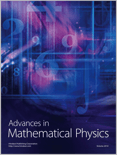
Advances in Mathematical Physics
Fostering Collaboration in Mathematical PhysicsAdvances in Mathematical Physics is a premier open-access journal published by HINDAWI LTD, dedicated to the dissemination of research in the fields of applied mathematics and physics. With its ISSN 1687-9120 and E-ISSN 1687-9139, this journal has been a vital platform for innovative studies since its inception in 2009, fostering a collaborative environment for researchers and professionals alike. The journal features a wide range of topics, including but not limited to mathematical models, computational physics, and interdisciplinary applications, thus attracting a diverse readership. Ranked in the Q3 quartile for both Applied Mathematics and Physics and Astronomy, it serves as a significant resource for academics looking to explore cutting-edge developments and theoretical advancements. With an emphasis on open accessibility, Advances in Mathematical Physics ensures that research findings are readily available to the global academic community, leveling the playing field for emerging scholars and seasoned researchers. By consistently showcasing high-quality manuscripts, the journal contributes substantially to the fields of mathematics and physics, encouraging scholarly dialogue and advancing knowledge across a myriad of applications.
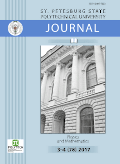
St Petersburg Polytechnic University Journal-Physics and Mathematics
Connecting Researchers to the Latest DiscoveriesSt Petersburg Polytechnic University Journal-Physics and Mathematics is a distinguished academic journal published by the Polytechnical University Publishing House, dedicated to advancing the fields of physics and mathematics. Established as an Open Access publication since 2013, this journal aims to facilitate the unrestricted dissemination of high-quality research, allowing global access to innovative findings and discussions. With its ISSN 2405-7223, the journal serves as a pivotal platform for researchers, professionals, and students keen on exploring the latest advancements and theoretical insights within these disciplines. The journal emphasizes rigorous peer-reviewed articles, promoting critical discourse and collaboration within the scientific community. By prioritizing open access, it enhances academic engagement and supports the ongoing development of knowledge crucial for addressing contemporary scientific challenges.

THEORETICAL AND MATHEMATICAL PHYSICS
Charting New Territories in Physics ResearchTHEORETICAL AND MATHEMATICAL PHYSICS, published by MAIK NAUKA/INTERPERIODICA/SPRINGER, is a premier journal dedicated to advancing the fields of Mathematical Physics and Statistical and Nonlinear Physics. With an impressive history spanning from 1969 to 2024, this journal serves as a vital platform for researchers, professionals, and students eager to explore cutting-edge theoretical frameworks and mathematical models. Although it currently holds a Q3 ranking in both its categories as per the 2023 metrics and is positioned within the Scopus ranks reflecting its growing influence, the journal continually aims to enhance its impact within the academic community. The publication does not currently provide open-access options, underscoring its collector’s nature in the dissemination of valuable research findings. Submissions are welcomed from diverse areas of theoretical physics, providing a rich and collaborative environment for the exploration of complex phenomena and the development of innovative methodologies.
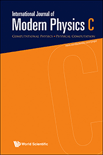
INTERNATIONAL JOURNAL OF MODERN PHYSICS C
Exploring the Depths of Modern Theoretical ConceptsINTERNATIONAL JOURNAL OF MODERN PHYSICS C, published by WORLD SCIENTIFIC PUBL CO PTE LTD, is a pivotal platform for disseminating groundbreaking research in the fields of computational theory, mathematical physics, and statistical physics. With an ISSN of 0129-1831 and an E-ISSN of 1793-6586, this esteemed journal, based in Singapore, serves a global audience of researchers and professionals who are dedicated to pushing the boundaries of knowledge in modern physics. The journal's rigorous selection process ensures the inclusion of high-quality articles that advance the understanding and application of complex theoretical concepts. Currently, the journal holds a commendable Q3 quartile ranking across several categories, including Computational Theory and Mathematics and Statistical and Nonlinear Physics, reflecting its influence and relevance in the academic community. Covering a wide array of topics from 1996 to 2024, the INTERNATIONAL JOURNAL OF MODERN PHYSICS C is not just a repository of research; it is a critical resource for students and scholars aiming to stay at the forefront of modern scientific inquiry.

EUROPEAN JOURNAL OF PHYSICS
Exploring the Depths of Scientific DiscoveryEuropean Journal of Physics, published by IOP Publishing Ltd, is a premier international journal serving the diverse field of physics and astronomy. With a commitment to advancing scientific knowledge since its inception in 1980, the journal provides a platform for original research articles, reviews, and topical discussions in various domains, including theoretical and experimental physics. Operating out of the United Kingdom, the journal has achieved a commendable Q2 ranking in the Physics and Astronomy (miscellaneous) category for 2023, reflecting its robust influence in the academic community, alongside a notable Scopus Rank that underscores its relevance in both the Social Sciences and General Physics and Astronomy fields. Although it does not currently offer open access, the journal's traditional publication model ensures rigorous peer review, maintaining high scholarly standards that are imperative for researchers, professionals, and students striving to stay ahead in their respective fields. Don't miss the opportunity to engage with cutting-edge research and contribute to the ongoing dialogue in physics by accessing this vital resource.
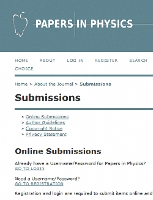
Papers in Physics
Advancing the frontiers of physics and materials science.Papers in Physics is a reputable, open-access journal dedicated to advancing knowledge in the diverse fields of physics, materials science, and theoretical chemistry. Published by the Instituto de Física Líquidos y Sistemas Biológicos in Argentina, this journal has been disseminating groundbreaking research since 2009 and has quickly established its place within the academic community. With a consistent commitment to accessibility, it serves as a vital resource for professionals, researchers, and students alike, enriching the discourse with innovative studies and findings. As recognized by its 2023 Scopus rankings, the journal occupies Q3 quartile positions across several categories, including Materials Science and Physics, illustrating its relevance and impact in the scientific landscape. The journal's breadth of research encompasses interdisciplinary approaches, fostering collaboration among scholars from various domains. Whether you are seeking to publish your own research or exploring the latest developments in physics and its related fields, Papers in Physics stands as a critical platform for the dissemination of knowledge and the advancement of science.

ZEITSCHRIFT FUR ANGEWANDTE MATHEMATIK UND PHYSIK
Cultivating Excellence in Applied Mathematics and PhysicsZEITSCHRIFT FUR ANGEWANDTE MATHEMATIK UND PHYSIK, published by Springer International Publishing AG, is a leading journal in the fields of applied mathematics and physics, highly regarded as evidenced by its prestigious Q1 rankings in 2023 across multiple categories, including Applied Mathematics, Mathematics (miscellaneous), and Physics and Astronomy (miscellaneous). With an ISSN of 0044-2275 and an E-ISSN of 1420-9039, this journal covers a broad spectrum of research from theoretical frameworks to practical applications, making it an indispensable resource for researchers, professionals, and students alike. With converged years running from 1950 to 2024, it offers a rich history of contributions to the scientific community and remains vital for current advancements in mathematics and physics. While not an open-access journal, its subscription model ensures high-quality, peer-reviewed content that fosters innovation and collaboration across disciplines. The journal is conveniently located in Cham, Switzerland, providing a central hub for global research dissemination in these critical areas of study.
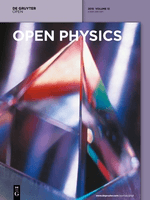
Open Physics
Advancing the frontiers of physics and astronomy.Open Physics, published by DE GRUYTER POLAND SP Z O O, is a leading open access journal dedicated to advancing the field of physics and astronomy. Established in 2015, this journal not only promotes the dissemination of innovative research but also emphasizes accessibility, allowing researchers, professionals, and students alike to freely engage with the latest advancements in various physics disciplines. With an impact factor that positions it within the Q3 category of the broader physics and astronomy community, Open Physics currently holds a respectable ranking of #102 out of 243 journals in its field according to Scopus, placing it in the 58th percentile. The journal encourages rigorous scholarship and the sharing of knowledge within a collaborative environment. Based in Germany, with its editorial office located in Warsaw, Poland, Open Physics is dedicated to fostering international dialogue and interdisciplinary research, making it an essential resource for those shaping the future of physical sciences.